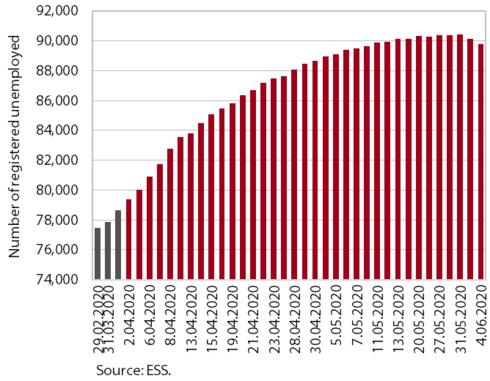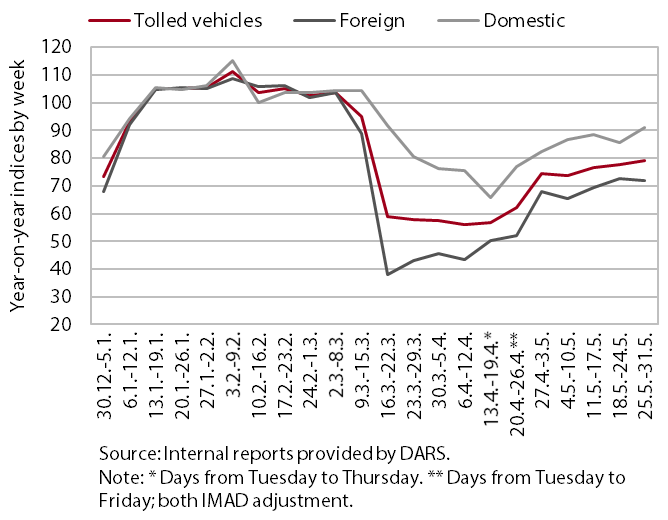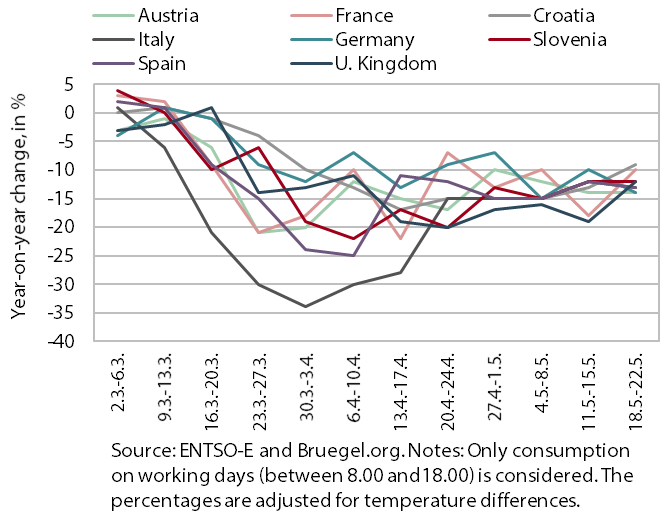Charts of the Week
Current economic trends from 1 to 5 June 2020: registered unemployment, traffic of electronically tolled vehicles and electricity consumption
The number of registered unemployed persons, which had increased by around one sixth (to slightly more than 90,000) from the beginning of the epidemic spread to the end of May, decreased slightly at the beginning of June. At the end of May, truck traffic on Slovenian motorways and electricity consumption remained significantly lower than in the same period of last year, but in the last weeks the year-on-year fall has moderated.
Registered unemployment, April – June 2020

The number of registered unemployed had started to rise markedly in mid-March, while in May the increase slowed and in the first days of June the number of unemployed has declined slightly. By the end of May, the number of unemployed persons had risen to 90,415, which is 25.6% more than one year earlier. On 4 June, a total of 89,765 persons were unemployed according to EES unofficial (daily) data, which is 0.7% less than at the end of May. Among the newly registered, significantly more persons than before the outbreak of the epidemic lost work because their fixed-term employment contracts were not extended (a reason more frequently cited among younger age groups) or for business reasons. The activities with the largest inflow are accommodation and food service activities, trade and manufacturing. With a smaller inflow into unemployment and a larger outflow into employment, the increase in the number of unemployed came to a halt in the last weeks and in the first days of June the number is already falling. This is related to the easing of containment measures and the adoption of the third legislative package of measures to mitigate the economic impact of the crisis.
Traffic of electronically tolled vehicles on Slovenian motorways, May 2020

Freight traffic on Slovenian motorways, which declined markedly after the adoption of measures to contain the epidemic, was around one fifth lower year on year in the last week of May. After a more than 40% decline in the weeks from mid-March to the second half of April, freight traffic was gradually rising until the end of May, but remained lower than in the same period of last year. The distance travelled by domestic and foreign trucks declined by around one tenth and around one quarter respectively. The fall in foreign truck traffic, which was initially much more pronounced than in domestic truck traffic, has decreased under the impact of EU measures for the free flow of goods across borders and due to the easing of measures in some neighbouring countries.
Electricity consumption, May 2020

After a pronounced decline in March and April, the year-on-year fall in weekly electricity consumption gradually started to slow in May. Electricity consumption, one of the indicators of economic activity, was on average 14% lower year on year in Slovenia at a weekly level in May (in April, with the spread of the epidemic, the decline was 20%). More and more measures being relaxed, in May, consumption also fell less than in previous weeks in most other countries. The only exception is Germany, with a 12% average decline in weekly consumption, which is more than the average weekly decline from the beginning of the crisis up to the end of April, when it was 9.5%.
